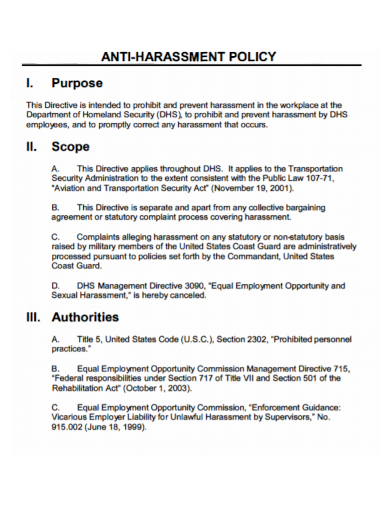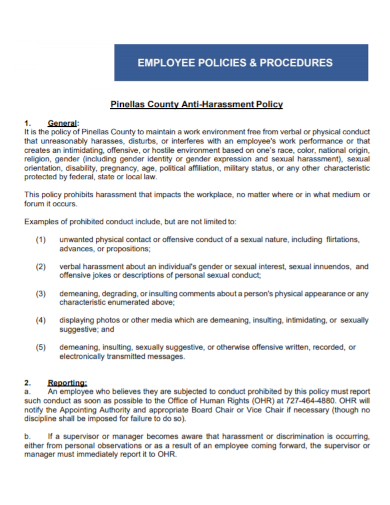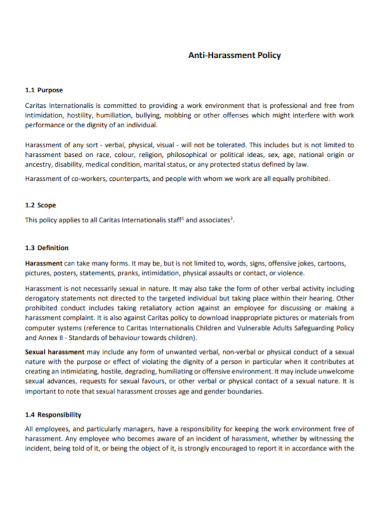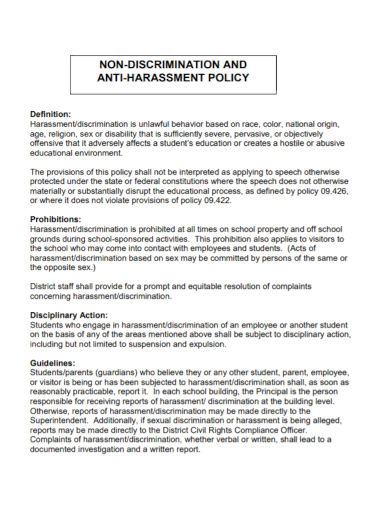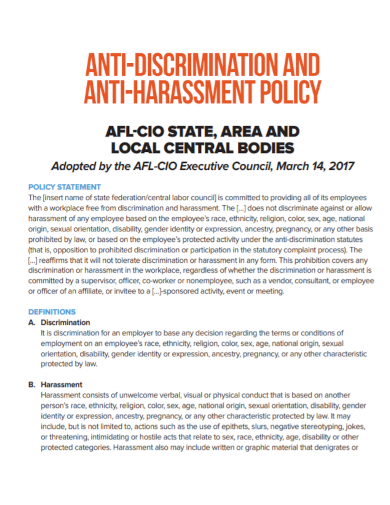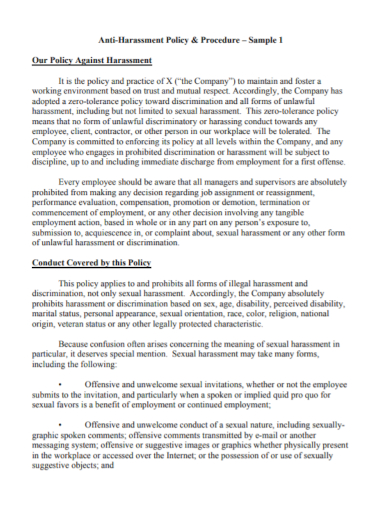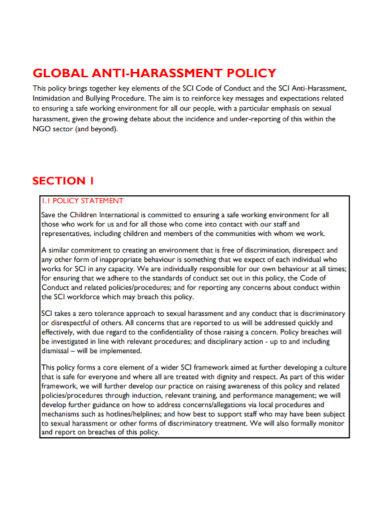Professionalism and respect in the workplace must always be upheld at all times. According to studies, 25% to 85% employees experience workplace harassment. Approximately 72% of sexual harassment victims in the workplace do not report it. In their lives, 81% of women have been subjected to sexual harassment. To avoid these sort of incidents, policies must be set in place in order to protect and safeguard the welfare and security of the employees. It’s crucial that policies like these are established in your company. In this article, we provide you with free and ready-to-use samples of Anti-Harassment Policies for you convenience. Keep on reading to find out more!
10+ Anti-Harassment Policy Samples
1. Anti-Harassment Policy
2. Sample Anti-Harassment Policy
3. Employee Anti-Harassment Policy
4. Anti-Harassment Policy Statement
5. Standard Anti-Harassment Policy
6. Non-Discrimination Anti-Harassment Policy
7. Anti-Discrimination Anti-Harassment Policy
8. Supervisor Anti-Harassment Board Policy
9. Anti-Harassment Procedure Policy
10. Global Anti-Harassment Policy
11. Anti-Sexual Harassment Policy
What Is an Anti-harassment Policy?
It’s essential because it emphasizes each employee’s responsibility for fostering a courteous and healthy workplace. A solid anti-harassment policy can help prevent harassment, make your workplace a secure and comfortable place for employees, and keep your business running efficiently. A strong anti-harassment policy is a powerful guidelines to create awareness and signal that any harassment will not be accepted— by having a written policy in place that prohibits it, it outlines behavior that might be considered harassment, and gives employees with ways to report it.
How to Make an Anti-harassment Policy
Without such policies in place to protect your employees’ safety, you are exposing your firm to undesirable consequences such as a poor work culture, low morale and productivity, and financial strain due to higher staff turnover. Implement a professional anti-harassment policy and give regular training for all employees to make it obvious that harassment of any kind is not tolerated at your organization. Aside from the variety of free Anti-Harassment Policy templates provided above, you can also try to make one of your own from scratch. If you’re interested in making a policy personalized to your own firm, here ae some general information you ought to consider before mocking one up:
1. Define behaviors and provisions that indicate harassment.
Your policy should include examples of harassing behavior, such as sexual comments, stories, and jokes, as well as physical contact, such as touching or squeezing. Essentially, your policy should be able to accurately and concisely define harassment. When it comes to any sort of harassment, the victim’s feelings and the impact of the harasser’s acts take precedence.
2. Provide a solid and convenient reporting mechanism.
Provide employees with the information they’ll need to make a complaint if they’re a victim or witness of any harassment in this area. The filing of complaint should be seamless and, depending the size of your company, there should be various compliant mechanisms provided. For example, designate numerous staff people, including a member of human services, to receive complaints. This way, if the one culpable is the anti-harassment supervisor themselves, there are still other avenues to report the incident.
3. Make the confidentiality of such complaints a top priority.
In your policy, include a confidentiality clause. Ensure that harassment allegations are handled as discreetly as possible and that personal information is kept private.
4. In light of the incident, specify the planned course of action.
Reiterate that the company takes sexual harassment very seriously in this section. Declare that infractions of the policy will not be allowed, and that harassers will face appropriate disciplinary action. For example, you may mention the possible consequences for someone who is determined to have sexually harassed another person, such as a verbal or written warning, a transfer, or dismissal.
FAQs
What does harassment look like in practice?
Derogatory jokes, racial slurs, personal insults, and statements of contempt or intolerance for a particular race are all examples of workplace harassment. Abuse can range from making fun of a worker’s accent to threatening or flashing discriminatory symbols to psychologically intimidate staff.
What is the most common form of workplace harassment?
Harassment of a sexual nature. The most common form of workplace harassment is well-known to us all, ranging from unwelcome and disrespectful comments to unwanted physical advances and requests for sexual favors.
What does it mean to be harassed?
Harassment is unwelcome conduct that is based on race, color, religion, sex (including sexual orientation, gender identity, or pregnancy), national origin, older age (beginning at age 40), disability, or genetic information (including family medical history).
The individuals you hire form the foundation of your workplace culture. Hiring ethical, courteous individuals can assist you in creating a friendly, nondiscriminatory workplace where employees feel heard and protected. As a result, all employees must be properly trained in both the prevention of sexual harassment and the policy itself. To help you get started with establishing a strong anti-harassment policy, download our customizable and printable samples of Anti-Harassment Policies today!
Related Posts
FREE 10+ Workplace Investigation Checklist Samples
FREE 10+ Investigation Checklist Samples
FREE 10+ Charity Equality and Diversity Policy Samples
FREE 8+ Sample Employee Complaint Forms
FREE 8+ Sample Employee Manual
FREE 7+ Employee Manual Samples
Things to Do When Resigning from an Internship
FREE 5+ Sample Code of Conduct
FREE 42+ Sample Claim Forms
FREE 10+ Business Travel Report Samples
FREE 7+ Sample EEOC Complaint Forms
FREE 7+ Sample Restraining Order Forms
FREE 7+ Sample Employee Complaint Form
FREE 6+ Sample Civil Complaint Forms
FREE 6+ Sample Printable Employee Handbook

